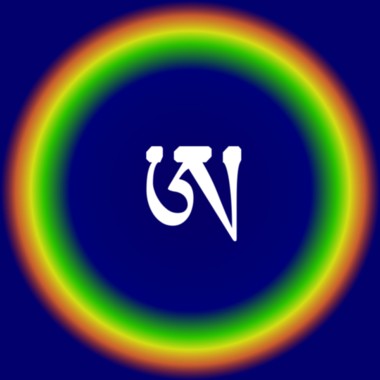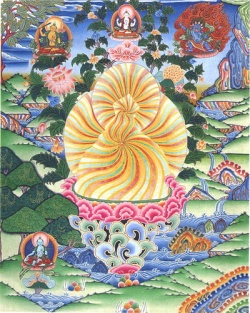Rainbow body
Rainbow body (Tib. འཇའ་ལུས་, ja lü; Wyl. 'ja' lus) — fully accomplished Dzogchen practitioners can dissolve their body at the time of death.
- Through the practice of trekchö, the practitioner can attain the so-called ‘rainbow body’, in which the body becomes smaller and smaller as it dissolves, emanating rainbow light, and finally only the hair and nails are left behind.
- Through the practice of tögal, the practitioner can dissolve his or her body into the ‘Light Body’ (Tib. འོད་སྐུ་, ö ku),
where the body transforms into light and disappears completely into space. This was done by Garab Dorje, Manjushrimitra, Shri Singha, Jnanasutra and Vairotsana.
- Another accomplishment of tögal practice is the ‘Rainbow Body of Great Transference’ (Tib. འཇའ་ལུས་འཕོ་བ་ཆེན་པོ་, ja lü phowa chenpo; Wyl. 'ja lus 'pho ba chen po),
where the master dissolves his body into rainbow light and lives for centuries in order to benefit others. Such was the case with Padmasambhava, Vimalamitra, Nyang Tingdzin Zangpo and Chetsün Senge Wangchuk.
Other Examples
- Nyala Pema Dündul (1816-1872)
- Khenchen Tsewang Rigdzin (1883-1958)
- Sonam Namgyal (d.1952/3)
- Khenpo Achö (1918–1998)
Further Reading
- Matthew Kapstein, 'The Strange Death of Pema the Demon-Tamer' in The Presence of Light: Divine Radiance and Religious Experience, ed. Matthew T. Kapstein, University of Chicago Press, 2004
- Sogyal Rinpoche, The Tibetan Book of Living and Dying, pages 171-173.
Source
In Dzogchen, rainbow body (Tibetan: Jalü or Jalus (Wylie 'ja' lus) is a level of realization.
This may or may not be accompanied by the 'rainbow body phenomenon'.
The rainbow body phenomenon has been noted for centuries, including the modern era.
Other Vajrayana teachings also mention rainbow body phenomena.
In Dzogchen
The rainbow body phenomenon is a third person perspective of someone else attaining complete knowledge (rigpa).
Knowledge is the absence of delusion regarding the display of the basis.
Rigpa has three wisdoms, two of which are kadag and lhun grub. Kadag (primordial purity) is the Dzogchen view of emptiness.
Lhun grub (natural formation) is the Dzogchen view of Dependent origination.
Throughout Mahayana, emptiness and Dependent origination are two sides of the same coin.
The lhun grub aspect has to do with esoteric practices, such as (but not limited to) Thödgal, that self-liberate the dependently originated human body into the Sambhogakāya (rainbow body phenomenon).
The symbol of Dzogchen is a Tibetan A wrapped in a thigle (see picture to the right).
The A represents kadag while the thigle represents lhun grub.
The third Wisdom, thugs rje (compassion), is the inseparability of the previous two wisdoms.
The ultimate fruition of the thodgal practices is a body of pure light, called a rainbow body (Wylie 'ja' lus, pronounced Jalü.)
If the four visions of thogal are not completed before death, then at death, from the point of view of an external observer, the following happens: the corpse does not start to decompose, but starts to shrink until it disappears.
Usually fingernails, toenails and hair are left behind (see e.g. Togden Urgyen Tendzin, Ayu Khandro, Changchub Dorje.)
The attainment of the rainbow body is typically accompanied by the appearance of lights and rainbows.
Some exceptional practitioners such as Padmasambhava and Vimalamitra are held to have realized a higher type of rainbow body without dying.
Having completed the four visions before death, the individual focuses on the lights that surround the fingers.
His or her physical body self-liberates into a nonmaterial body of light (a Sambhogakāya) with the ability to exist and abide wherever and whenever as pointed by one's compassion.
List of those reported to have attained the rainbow body
- Shardza Tashi Gyaltsen (1935)
- Shug-gseb rJe-btsun Cho-nyid bzang-mo (b.1852, Attained 'ja'- lus in 1953.)
- Kenchen Tsewang Rigdzin disappeared alive in 1958.
- Ayu Khandro (1953)
- Nima Cultrim Rinpoche Teacher of Arta Lama
- Togden Ugyen Tendzin (1962)
- Khenpo A-chos (1998)
Shijie
Shijie (屍解) was a practice whereby Daoists transcended death through means of a simulated corpse.
This enabled them to live for long periods of time.
Other forms of transcendence which did *not* use the simulated corpse method resulted in flying into the heavens, sometimes in broad daylight, and sometimes on celestial chariots.

